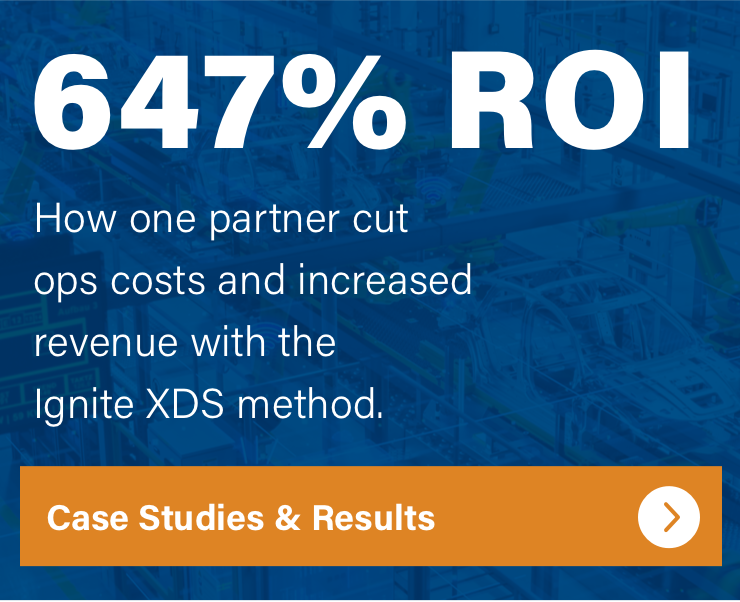
Culture Impacts Growth: How One B2C Company Rebuilt Culture and Reclaimed Momentum
When leadership changes, culture follows. And when culture shifts, so does business performance, sometimes for better, often for worse.
Transitions breed uncertainty. Uncertainty breeds hesitation. And hesitation stalls growth.
At Ignite XDS, we’ve seen this cycle play out repeatedly: leadership turnover, cultural erosion, employee disengagement, declining customer experiences, and a direct hit to the bottom line. The pattern is clear. The solution is clearer. During these pivotal moments, culture cannot be left to chance.
One of our B2C clients, a seller of high-ticket consumer products, faced exactly this inflection point. A sour leadership transition left their workplace fractured. Morale was low, burnout was high, and both sales and employee retention were heading in the wrong direction.
This is the story of how they rebuilt their culture from the inside out and how you can do the same.
The Starting Point: Burnout, Turnover, and a Brand at Risk
This wasn’t a culture problem waiting to happen. It was happening.
The company's high-pressure environment, already demanding by nature, had been pushed to the brink. Long hours and unclear leadership had worn down both management and frontline teams. Turnover was rising. Sales had plateaued. And a once-strong brand was losing internal and external trust.
Here’s the reality:
Disengaged employees don’t just leave jobs. They erode customer experience before they walk out the door.
Recognizing this risk, the client’s leadership turned to Ignite XDS for a cultural reset. Not a surface-level “let’s host a pizza party” fix, but a meaningful rebuild designed to create internal alignment and external impact.
Building Intentional Culture: Start with System, Not Symbolism
Culture can’t be forced. And it can’t be faked.
Authentic, lasting cultural change requires:
- Honest diagnosis of what’s broken.
- Intentional actions from leadership.
- Empowerment at every level of the organization.
Here’s how we helped the client get there:
1. Diagnose the Real Friction
We worked closely with their leadership to map cultural pain points. Where were the disconnects? Where was trust breaking down? Crucially, we didn’t stop at surface symptoms. We went deeper to understand the structural and emotional root causes behind disengagement.
2. Build Internal Champions
Top-down mandates fail. Culture thrives when it’s co-created.
We identified high-trust employees across departments to serve as engagement champions. These individuals weren’t always in leadership roles, but they had influence. When they spoke, people listened. When they led, others followed.
3. Form Cross-Department Committees
We helped establish internal committees designed to foster connection across generational, departmental, and leadership lines. These groups were empowered to plan initiatives, create feedback loops, and build community authentically.
The result? Employees began to see their fingerprints on the culture, not just management’s.
4. Make Leadership Visible—For Real
This wasn’t about leaders giving speeches at town halls. It was about active, visible participation in daily culture.
- Walking the floor.
- Attending committee-led events.
- Hosting open forums and genuinely listening.
When leaders show up with humility and presence, trust follows.
5. Embrace Experimentation
Not every initiative stuck but that was expected. The client understood that cultural transformation is iterative. They empowered their committees to try new ideas, monitor engagement, and refine based on what resonated.
Delegation created ownership. Ownership sustained momentum.
The Impact: Measurable Improvements in Engagement and Growth
Within 12 months, the results were clear and measurable:
- Retention rates improved. Turnover slowed as employees saw renewed purpose and connection in their work.
- Engagement climbed. Employees participated in initiatives, contributed ideas, and began to rebuild pride in the brand.
- Sales rebounded. Happier, engaged employees delivered better customer experiences—translating into stronger customer retention and a resurgence in sales growth.
Culture wasn’t just an internal win. It became an external advantage.
Bottom line: Culture is not a soft metric. It is an operational and financial lever.
What Every Business in Transition Needs to Know
Whether you’re navigating leadership turnover, expansion, or even just a period of stagnation, the lessons from this transformation apply.
1. Culture is Holistic
Good culture isn’t a campaign, it’s a system. It flows from leadership to frontline, across departments, and into the customer experience. B2B or B2C, it doesn’t matter. Culture touches everything.
2. Bad Managers Create Disengagement
No culture program can outpace toxic leadership. Do your due diligence. Actively solicit feedback, investigate warning signs, and remove leadership blind spots before they erode trust.
3. Performative Culture Fails
Employees see through hollow efforts. True change requires consistency, authenticity, and patience. Small, meaningful actions build credibility. Forced fun does not.
4. Communication Must Be Two-Way
An open-door policy isn’t enough. Leaders need to actively seek out and act on employee input. Consider tools like:
- Regular listening sessions
- Anonymous feedback channels
- Leadership “office hours”
Presence matters. Not as micromanagement—but as proof that leadership cares about every role in the company’s success.
5. Cross-Departmental Collaboration Drives Empathy
Culture strengthens when employees understand perspectives beyond their daily work. Cross-functional initiatives foster empathy, idea-sharing, and operational alignment.
6. Recognition Is a Growth Strategy
Celebrate contributions at every level. Recognize both office-based and shop-floor achievements. Highlight small wins as well as major milestones. Reinforce that every employee moves the business forward.
7. External Partners Accelerate Change
Cultural transformation is hard to lead from the inside. External partners bring perspective, accountability, and proven strategies. They spot blind spots. They sustain momentum. And they free internal leaders to balance operational priorities while driving cultural progress.
Culture Drives Performance But Only If You Build It With Intention
Here’s the truth:
When culture improves, everything improves.
Retention climbs. Customer experience sharpens. Growth becomes sustainable.
But only when culture is treated as an operational priority, not a side project.
If your organization is navigating change or if you’ve simply recognized that your culture isn’t fueling growth, it’s time to act.
We’ve helped companies across industries rebuild their culture from the inside out, creating systems that drive both employee engagement and bottom-line performance. And we can do the same for you: Review client case studies on bottom-line impact from culture transformation.


